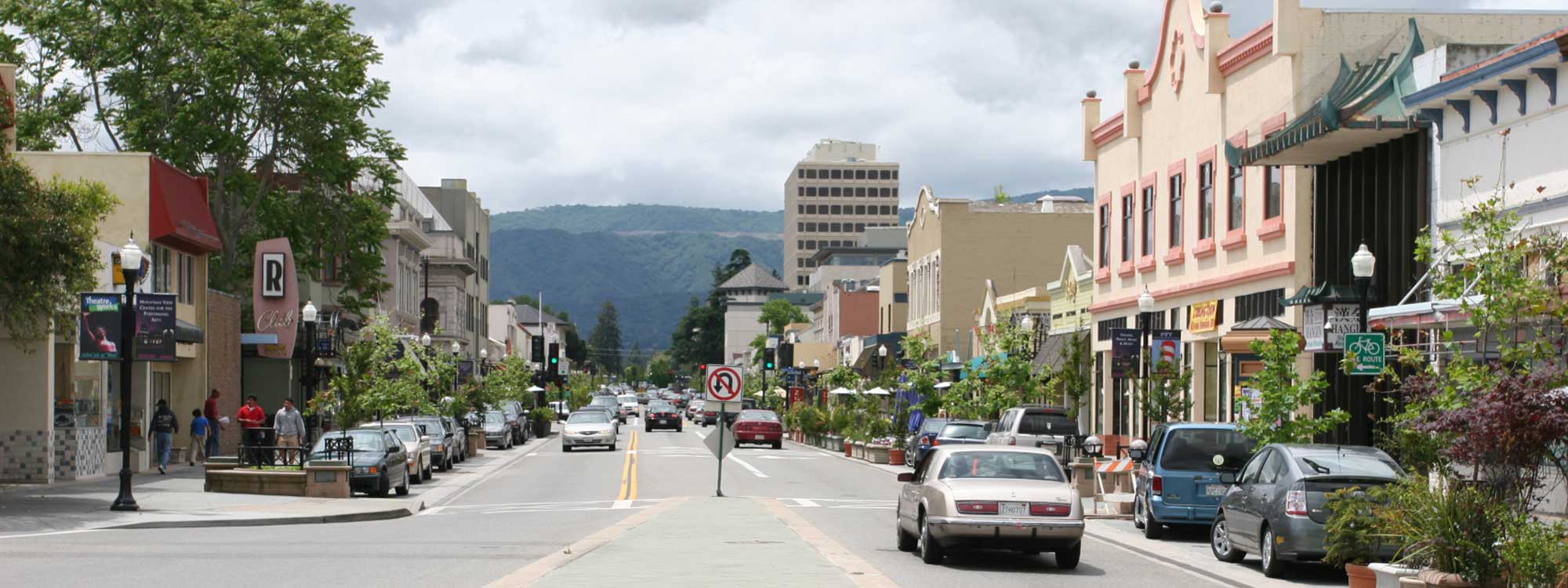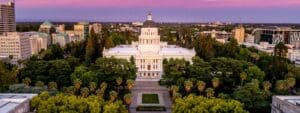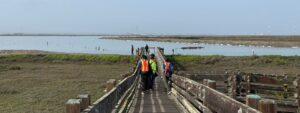In downtown Mountain View, Castro Street wasn’t always Castro Street.

Freedman, founding partner of the urban design firm Freedman Tung + Sasaki, has many downtown projects under his belt. He has become widely known for providing communities with creative and effective solutions to revitalize their downtown districts and regional retail centers. As with Castro Street, Freedman has a flare for working with state-of-the-art “form-based” development standards and regularly develops master plans for districts, redevelopment and infill sites.
Greenbelt Alliance’s Ellie Casson caught up with Michael Freedman via email in advance of the April 30 Walk the Talk Forum in—where else?—Mountain View.
Greenbelt Alliance: You played a role in the creation of the plan for Castro Street. Can you talk a little bit about that process? What was Castro Street like when you were working on the new plan? Were residents of Mountain View able to envision a new future for Castro Street?
Michael Freedman: The redesign of Castro Street was one element of a comprehensive strategy to revitalize downtown Mountain View. When I first came to Mountain View, the downtown was devoid of pedestrian activity. Castro Street was categorized as an arterial roadway. The road featured four through lanes and a central turning lane, which left little space to provide an environment for shopping and strolling. As you would expect, the district performed poorly as a business district. There appeared to be no one on the street, and the visual quality was depressing, to say the least.
Our success in instigating the dramatic turnaround of downtown was entirely due to the presence of a uniquely talented group of people on City staff, under the leadership of Bruce Liedstrand—the most talented City Manager I have encountered in 20+ years working with cities. Larry Janda was the leader in the Public Works Department; the late Steve Unankst was Zoning Administrator, Ken Alsman Principal Planner, and Diana Whitaker Downtown Revitalization Manager. This group was unique in several ways: besides being very intelligent, they were very interested in exploring ideas that were outside the mainstream; they were nonideological, looking for practical solutions to achieve real results; and they liked each other and enjoyed working together. Even though I was a consultant, they made me feel like we were in it together.
This was all made possible and pushed to its limits by Bruce Liedstrand. Bruce believed that the key to the revitalization was to develop, draw, and share a clear and detailed vision of what a great downtown would look like and feel like. So we began at the end—with the desired outcome, and worked our way backwards to figure out how to make that outcome a reality. As a result, people came to realize that the physical and policy conditions effecting downtown were entirely wrong and needed to be completely redone.
We ended up completely rewriting the zoning for the Downtown District—we actually implemented what is now called a “form‐based code” in the form of a the Downtown Precise Plan; we completely redesigned Castro Street to provide an environment that prioritized the needs of shops, pedestrians, and motorists destined for a shop. We fought successfully to get the light rail stop located in the downtown and then designed and implemented a completely different kind of transit station, one that doesn’t let the parking facilities separate the transit riders from the district.
We implemented a Downtown Business Recruitment Program to bring in missing anchor businesses to help kick‐start revitalization—two recruited businesses were a bookstore‐café on a key corner and a brew pub. Both were instant successes from the moment they opened, creating the kind of buzz that you need to change the image of a long‐dead downtown.
Then, even more than now, people were very worried about density and traffic. To revitalize downtown, we knew that we needed to substantially increase the allowable heights and densities, and that we needed to replace one or more of the five traffic lanes with more on-street parking spaces. This was extremely controversial, and there was some fierce opposition to the proposals.
If you want more detail about how Downtown was revitalized, I recommend that you check out “Downtown Mountain View ‘Secrets of Success’” by Bruce Liedstrand at
http://www.commonsensecommunitydesign.org/CommonSenseCommunityDesign/Secrets_of_Success.html.
GA: Your work is centered around reimagining and revitalizing cities and neighborhoods. Do you think that there are some specific ingredients that are essential for successful redevelopment?
MF: All cities are unique, but the suburbs were constructed at pretty much the same time, in response to the same set of forces and ideas that reigned in the post‐war period, and this has resulted in a nearly identical urban structure and very similar set of challenges and opportunities that really require very similar approaches in response to today’s greatly transformed social and economic conditions.
First, centers. Whether you care about economic prosperity or sustainability (or both), centers are the key to success in the current new era. Centers—downtowns, city centers, neighborhood centers, workplace district centers—are characterized by intensity, synergy and mix. It is critical to help communities get the point that the development of centers does not in any way threaten the single family neighborhoods or the suburban way of life.
Second, and related to the formation or revitalization of centers, retail uses must be positioned strategically. Cities must wake up to the fact that the most important and most difficult decision in the design of the suburban metro area is where (and how) to build the retail. The retail is the precious city‐ building commodity. Urban vitality is what will sell homes, draw the “talent” and nurture innovation. Whereas commercial strips were key to economic success in suburban cities for the over forty years, now Strips really hold cities back. This is why the region‐scale Grand Boulevard Project is so important to cities on the Peninsula. It represents an opportunity to explore and define frameworks to realign retail with the forces of prosperity, while providing an example to the country as to how to transition to a more successful and appropriate urban pattern.
Third, development regulations organized by use and density no longer fit the requirements to guide growth and change in response to contemporary market and social preferences. Development regulations must be reorganized on the basis of the type of city district—downtown, neighborhood center, residential neighborhood, workplace district, etc. — any given property is located within. Land use becomes just another ingredient, not the defining one; the defining one shifts to the type of district.
And finally (for now): a Skillful Champion. A highly placed city official is absolutely committed to doing what is necessary to bring the vision all the way to successful implementation—could be a mayor, city manager, community development director, but the loyal and essential mid‐level staff cannot pull off what is needed without that highly placed leader ready to take risks and be the spokesperson.
GA: It’s challenging to keep residents involved in planning. Do you have any success stories?
MF: For better or worse, it is really impossible to do anything significant in terms of reimagining and reshaping the pattern of the built environment in America without extensive community involvement.
We have found that the key is to share understandings and learning with all participants so that they can make up their own minds about what to do in a more informed way than if they are simply asked what they think. I find that people who attend public workshops often have a latent interest in how cities work and they enjoy learning something new, so we begin most community meetings with a presentation on such topics, using pictures of other places and then of the locality to show how the principles under discussion apply to the area in question.
GA: What is the most rewarding thing about your job?
MF: You know that movie, “Gone in 60 Seconds” where Nicolas Cage says he didn’t steal cars for money or glory, he did it for the cars. Well for me, it’s the cities. I really love cities—learning about them, helping to make them as good as they can be, and of course living in them, going out on the town. And you know when you really transform a place for the better, you really deliver what you said was possible, the feeling of being of use, being a valued member of the community, is hard to beat.
GA: What do you love about the Bay Area?
MF: The feeling of being in the cradle of innovation. Right now we are on the leading edge of the very beginning of a sea change in how we physically design the districts where knowledge‐based work takes place. This is beginning in downtown San Francisco, but it is going to explode out in to the whole region any minute now.
Also, my wife Suvanna and I love the multi‐ethnic, multi‐cultural blending in a non‐ghettoized way—I mean many cities have ethnic areas, China Town, Little Italy, etc. and we of course of those kinds of districts too, but in San Francisco and various Bay Area communities we also have plenty of mix within various districts. The best of the Bay Area gives one a glimpse into what a true World City or World Region could be like, old antagonisms and stereotypes left to fade behind us, replaced by a more nuanced and authentic understanding of the different cultural flavors.
Read the original interview: 2012-4-26_Ellie Casson_Interview Q&A (PDF)
Photo: Ian Fuller via Flickr




